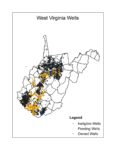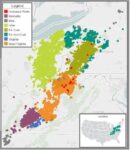by George Monk [gmonk@citynet.net] & Dave McMahon [wvdavid@wvdavid.net]
It is becoming more and more evident that testing of a well or spring water source, especially a household/drinking water source, is an absolute necessity before a natural gas well is drilled in one’s area. This is called baseline testing and the lab results form the basis of determining later if nearby drilling caused a change in water quality. If you later find that your water has been affected and there was no baseline test, it is still possible to establish that your water was affected by the driller, but it is much more difficult. If you have refused the driller’s test (if your well or spring is within 1,000 feet of a proposed or existing gas well) or do not have one of your own done, then you can count on the driller to say that your water was bad before they drilled.
Contaminated water is a serious issue. Pollution can include carcinogens like arsenic or benzene and a host of other chemicals not even examined in these laboratory tests. For example, methane in home water supplies has caused home explosions, and the state does require analysis of methane. However, in Pennsylvania, USGS researchers found elevated levels of barium and arsenic in methane migrations from gas wells to private drinking water supplies, which are not on the state’s list of testing parameters.
The state requires drillers to offer to do some testing, but it is limited. Drillers are only required to offer to test “any wells or springs located within one thousand 1,000 feet of the proposed gas well that is actually utilized by such owner or occupant for human consumption, domestic animals, or other general use.” If you are within 1,000 feet, make sure the driller knows what wells or springs are nearby and utilized by you. If you are more than 1,000 feet away and you want them to do testing, you should request the test by contacting the driller through a certified return receipt letter. This way the driller will be more likely to respond to your request.
Drillers do their testing according to a list of criteria furnished by the DEP Office of Oil and Gas (see below). These criteria do not include heavy metals. (The EPA recommends home water supplies be tested for chloride, sodium, barium and strontium when there are gas drilling operations nearby.)
Nor do the state’s criteria include all types of contamination that can occur. While it is impossible to test for everything, the state’s criteria are perhaps more limited than they should be. Drillers will sometimes test for a wider range of constituents than the state requires, but usually not. Again, if you want them to test for more than is required, you can ask the driller to do a more extensive test.
|
Office of Oil and Gas’ Required Criteria |
Maximum Allowable Concentration |
| pH | |
| Iron |
0.3 ppm |
| Total Dissolved Solids (TDS) |
500 ppm |
| Chloride |
250 ppm |
| Detergents (MBAS) | |
| Methane | |
| Coliform Bacteria |
See http://water.epa.gov/drink/contaminants/index.cfm for allowable concentrations of these and other contaminants in drinking water.
Concerned home owners who want a more extensive baseline test, as well as those whose wells are outside the 1,000 foot limit, have to fend for themselves. They have to search out a laboratory, determine what constituents should be tested for, and pay for the work.
One option is to hire an environmental firm to do the work of collecting the samples and doing the testing (some internally and some using independent commercial labs), as well as an analysis of and report on the test results. Some of these firms are listed on our website. This can be expensive for the ordinary farm owner, but it is the best idea if you end up in court after a driller ruins your water.
Another alternative is to contact an independent water testing laboratory on the state’s list of approved water testing labs (the list of commercial labs is available here) and ask them to collect samples for you. They usually charge mileage and an hourly rate. This is less expensive than the full service given by an environmental firm, but is better than collecting the samples yourself. This option can still be expensive.
A third option is to collect samples yourself using your own bottles, or bottles provided by a laboratory, and taking them to the laboratory yourself. This is the least expensive way to go.
If you collect the samples yourself, you need to do some things so your samples will be admissible in court later, if necessary. To make your samples admissible and believable to a jury, it is important to show a “chain of custody” so you can prove that your sample was taken and tested without being tampered with. (Contact us or click here for more information on how to collect a water sample.) Even if you have limited means and probably couldn’t afford a lawyer if a problem arises, it is a good idea to know what’s going on with your water. The DEP may accept your test results and make the driller fix your water.
Testing for every possible contaminant is not necessary. To find out if something has gone wrong during drilling or fracturing, a limited list of constituents to test for can be created. We feel that the following constituents should be analyzed: chloride, arsenic, barium, iron, lead, magnesium, and sodium. Labs will charge from about $75 to $100 for this type of work if you collect the sample. (Click here for allowable concentrations of these contaminants in drinking water.)
A second group of constituents called BTEX should be analyzed, if you can afford it. These are benzene, toluene, ethylbenzene and xylenes. Labs will charge from about $75 to $100 for this group of tests if you collect the sample. The state has strict standards for the allowable concentration of these chemicals in water, as does the EPA. (See link in previous paragraph.)
The final constituent is methane and it will cost a further $75 or more for this test if you collect the sample. Not all labs can test for methane in water. REIC Laboratories in the southern part of the state or Pace Laboratories for the northern part of the state can do this test.
The barebones metals and chloride test will often indicate if something bad has happened, but testing for BTEX and methane is more comprehensive.
Discoloration, bad taste or odor, or fizzing of water are all indications that a nearby gas well is causing problems. Of course, if something bad happens and a another round of tests are required, complain to the DEP Office of Oil and Gas and they will usually make the driller do a second, more thorough, round of tests. Again, you may want to do your own tests at this point if you can afford it.
In conclusion, baseline testing should be considered by those living near drilling activity. If testing wasn’t done previously and your water has changed, it is still worthwhile to have laboratory analysis. A neighbor’s baseline test or water testing when the well was drilled might prove to be a useful comparison.
For more information on water testing, contact us at 1-866-WVB-FAIR or info@wvsoro.org. If there is a problem with your drinking water, contact the Office of Oil and Gas at (304) 926-0499 and notify WV-SORO.
Additional Resources on Water Testing: Getting the Waters Tested — PowerPoint Presentation on Base Line Water Testing




